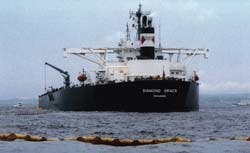Diamond Grace supertanker, shown aground on Nakanose reef in Tokyo Bay, is surrounded by containment booms after spilling almost 10,000 bbl of crude oil in the bay early in July. The tanker is co-owned by Japanese firms Nippon Yusan KK and Mitsubishi Oil Co.
Japanese authorities were continuing to contain and clean up a big oil spill in Tokyo Bay last week.
It was the second major tanker oil spill off Japan this year-albeit a fraction of the volume first reported, which would have made it the country's biggest oil spill (OGJ, July 7, 1997, Newsletter).
Ironically, the accident came shortly after Japanese authorities declared there were no lasting environmental effects stemming from a January incident in which the Russian tanker Nakhodka broke apart in a storm, spilling about 30,000 bbl of heavy fuel oil off Japan.
The Nakhodka spill has spawned efforts by Japanese authorities to toughen tanker regulations (OGJ, Apr. 21, 1997, Newsletter).
Lower volume estimate
Crude oil spilled July 2 from a supertanker co-owned by Nippon Yusan KK and Mitsubishi Oil Co. in Tokyo Bay amounted to about 1,550 kl (9,688 bbl) of crude, only about a tenth of the figure reported the night of the spill, Chief Cabinet Sec. Seiroku Kajiyama said July 3.
Kajiyama made the announcement at a hastily arranged news conference. The government announced late July 2 that about 14,000-15,000 kl (87,500-93,750 bbl) of crude oil had spilled from the supertanker.
The spill from the Panamanian-registered, Japanese-owned 259,999-dwt Diamond Grace spread extensively across the bay after the supertanker ran aground on Nakanose reef early July 2 about 6 km southeast of Yokohama port's Honmoku Pier. The reef, at a subsea depth of 37 ft, is one of Tokyo Bay's most notorious marine hazards.
The drifting slick washed ashore at cargo piers at Honmoku and Daikoku in Yokohama and at Ogishima and Higashi-Ogishima in Kawasaki early July 3, according to the Maritime Safety Agency (MSA). But MSA says that the size of the spill has considerably dwindled due to containment efforts.
Cleanup crews retrieved more than 570 kl of the spilled oil July 2-3, adding that 19 km of containment boom has been deployed in the bay. No immediate damage to the fisheries industry has been reported.
The downward correction on the spill volume oil was reported to Prime Minister Ryutaro Hashimoto by Transport Minister Makoto Koga, Kajiyama said. Most of the crude initially believed to have leaked was found to have remained inside the tanker hull, he said. Koga subsequently apologized for the initial misleading statements about the spill's size, admitting that the government had acted before getting a full grasp of the situation.
The earlier figure was based on a report from Nippon Yusen, co-owner of the Diamond Grace. The actual oil volume spilled from the tanker was based on a precise check conducted later, Koga said.
"After receiving a report on the error, I gave instructions to check the new figure again because we should not make a mistake twice and cause fear among the public," said Koga.
What happened
When the tanker ran aground on Nakanose shoal early July 2, three of the vessel's tanks were damaged, puncturing the No. 1 and 3 starboard tanks.
The ship was transporting crude from the U.A.E. The No. 2 tank was empty.
The empty tank took most of the flow from damaged areas, saving Tokyo Bay from the massive spill originally envisioned, the Transport Ministry said.
The Diamond Grace suffered damage on the starboard side, according to government accounts. Bulkheads separating full tank No. 1 from empty tank No. 2 and full tank No. 3 were breached, and the crude flowed into the empty tank.
But because tank No. 2 had some exterior damage, 1,556 kl of oil ended up in the bay. Nippon Yusen had believed there was seawater in the No. 2 tank.
The government will investigate the cause of the accident, Kajiyama said, noting it might simply have been a careless mistake.
Nippon Yusen unveiled a report submitted by the tanker's caption, Hidenori Tsunematsu, that his ship ran aground when it tried to pass between two fishing boats by slowing down. The tanker then was carried by the tide and wind gusts, it said.
The report said the tanker suffered a strong shock immediately after it started running at dead slow. The pilot on board the Diamond Grace told MSA officials that the accident was not caused by mechanical trouble.
The MSA has since determined the accident was due to an operational error and has decided to seek an indictment of the captain, Hidenori Tsunematsu, and pilot, Masaharu Ushio, of the supertanker for allegedly erring in measuring distances and neglecting to exercise sufficient caution in navigating the vessel.
The MSA said that during questioning, Ushio admitted that he had committed piloting errors, while Tsu- nematsu testified that the tanker had reduced speed to avoid hitting fishing and other vessels in front of the ship's starboard side.
However, MSA said that authorities did not find any indications that the tanker had slowed down before the accident.
Hashimoto pledged maximum efforts to contain the spill and to clean it up.
"If you look into the details, there are many questions, including why (the captain) mismanaged the tanker," Hashimoto said
Environmental concerns
Meanwhile, environmental groups have expressed concern about the potential damage from the spilled oil on wildlife and tidal flats in the Tokyo Bay area.
"It is difficult to predict what the effects on the environment will be," said Tomohiro Shishime of the Environment Agency's Water Quality Bureau. The agency, however, has been monitoring the air since the accident and said it has returned to normal.
According to the agency, the density of nonmethane hydrocarbons, including benzene, temporarily rose to as much as 20 times the normal figure at three observation sites at Urayasu and Ichikawa, both in Chiba Prefecture, shortly after the oil spill occurred.
Copyright 1997 Oil & Gas Journal. All Rights Reserved.


